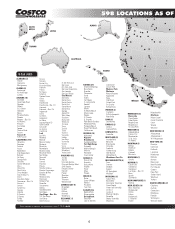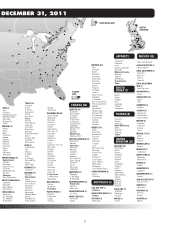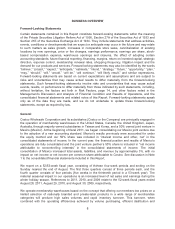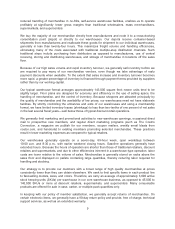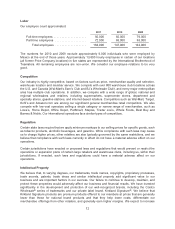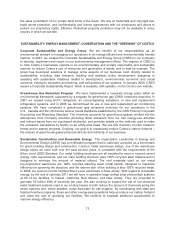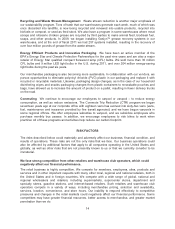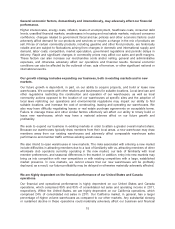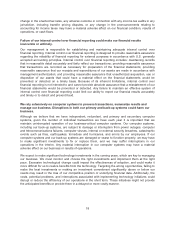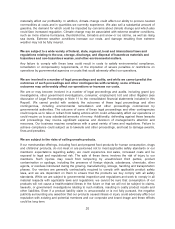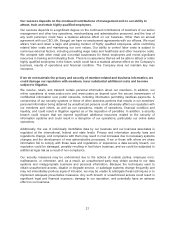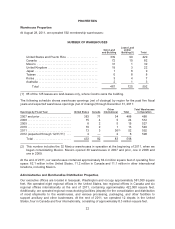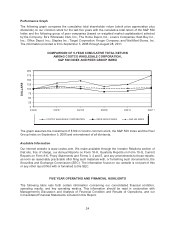Costco 2011 Annual Report Download - page 18
Download and view the complete annual report
Please find page 18 of the 2011 Costco annual report below. You can navigate through the pages in the report by either clicking on the pages listed below, or by using the keyword search tool below to find specific information within the annual report.results. Declines in financial performance of our United States operations, particularly in California, and
our Canada operations could arise from, among other things: failing to meet targets for warehouse
openings; declines in actual or estimated comparable warehouse sales growth rates and expectations;
negative trends in operating expenses, including increased labor, healthcare and energy costs;
cannibalizing existing locations with new warehouses; shifts in sales mix toward lower gross margin
products; changes or uncertainties in economic conditions in our markets, including higher levels of
unemployment and depressed home values; and failing to consistently provide high quality products
and innovative new products to retain our existing member base and attract new members.
We depend on vendors to supply us with quality merchandise at the right prices in a timely
manner.
We depend heavily on our ability to purchase merchandise in sufficient quantities at competitive prices.
We have no assurances of continued supply, pricing or access to new products, and any vendor could
at any time change the terms upon which it sells to us or discontinue selling to us. Member demands
may lead to out-of-stock positions of our merchandise, leading to loss of sales and profits.
We purchase our merchandise from numerous domestic and foreign manufacturers and importers and
have thousands of vendor relationships. Our inability to acquire suitable merchandise on acceptable
terms or the loss of key vendors could negatively affect us. We may not be able to develop
relationships with new vendors, and products from alternative sources, if any, may be of a lesser
quality or more expensive than those from existing vendors. Because of our efforts to adhere to high
quality standards for which available supply may be limited, particularly for certain food items, the large
volume we demand may not be consistently available.
Our suppliers are subject to risks, including labor disputes, union organizing activities, financial
liquidity, inclement weather, natural disasters, supply constraints, and general economic and political
conditions, that could limit their ability to timely provide us with acceptable merchandise. For these or
other reasons, one or more of our suppliers might not adhere to our quality control, legal or regulatory
standards. These deficiencies may delay or preclude delivery of merchandise to us and might not be
identified before we sell such merchandise to our members. This failure could lead to litigation and
recalls, which could damage our reputation and our brands, increase our costs, and otherwise hurt our
business.
Disruptions in our depot operations could adversely affect sales and member satisfaction.
We depend on the orderly operation of the receiving and distribution process, primarily through our
depots. Although we believe that our receiving and distribution process is efficient, unforeseen
disruptions in operations due to fires, hurricanes, earthquakes or other catastrophic events, labor
shortages and disagreements or shipping problems, may result in delays in the delivery of
merchandise to our warehouses, which could adversely affect sales and the satisfaction of our
members.
We may not timely identify or effectively respond to consumer trends, which could negatively
affect our relationship with our members, the demand for our products and services, and our
market share.
It is difficult to consistently and successfully predict the products and services our members will
demand. Our success depends, in part, on our ability to identify and respond to trends in demographics
and consumer preferences. Failure to timely identify or effectively respond to changing consumer
tastes, preferences (including those relating to sustainability of product sources) and spending patterns
could negatively affect our relationship with our members, the demand for our products and services
16


